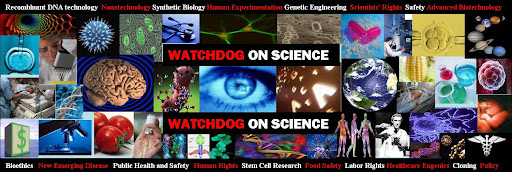 |
| Human Infectious Agents BL3 Labs |
The government gives large amounts of public money to universities to perform dangerous biological laboratory research using a variety of native and genetically engineered infectious agents. These agents are capable of causing disease.
At the same time adequate safety measures for the public and the worker remain unmet.
Biotech workers continue to lack rights to exposure records for healthcare, lack rights to safe work environments, lack rights to safety forums and lack whistleblower protections, making the probability of a biological release into the environment more probable and imminent.
No oversight on research laboratories or private laboratories are mandated. OSHA and other public agencies have been shown to be inept in protecting scientists, as well as, the public's interest, as biological technologies in BL2 and BL3 laboratories advance and threaten public health and safety.
Despite the fact that the public has to pay for this research, a network of cloaked secrecy and lack of public rights purposely prohibit public transparency within this industry.
Sources of biological releases are difficult to track, but will cause increases in cancer, re-emerging disease, new emerging disease and chronic illness.
At the same time adequate safety measures for the public and the worker remain unmet.
Biotech workers continue to lack rights to exposure records for healthcare, lack rights to safe work environments, lack rights to safety forums and lack whistleblower protections, making the probability of a biological release into the environment more probable and imminent.
No oversight on research laboratories or private laboratories are mandated. OSHA and other public agencies have been shown to be inept in protecting scientists, as well as, the public's interest, as biological technologies in BL2 and BL3 laboratories advance and threaten public health and safety.
Despite the fact that the public has to pay for this research, a network of cloaked secrecy and lack of public rights purposely prohibit public transparency within this industry.
Sources of biological releases are difficult to track, but will cause increases in cancer, re-emerging disease, new emerging disease and chronic illness.
______
In 2003, UTHSC was awarded nearly $18 million in federal funding from the National Institutes of Allergy and Infectious Disease (NIAID) to be used to build a laboratory on the UT-Baptist Research Park site for biomedical and biodefense research and research training. The UTHSC RBL is one of 13 NIAID funded Regional Biocontainment Laboratories in the country. The primary purpose of the research conducted at the RBL will be to develop new drugs, vaccines, and diagnostics to protect the general population from infectious diseases and bioterrorism. One of 13 NIAID funded regional biocontainment labs in the country; the UTHSC RBL will be limited to research requiring Biosafety Level 3 (BSL-3) containment as defined by the Centers for Disease Control. BSL-3 facilities are designed to safely and effectively study contagious materials. Scientists at the UT RBL will investigate: multi-drug resistant tuberculosis, tularemia, streptococci, cholera, and Chlamydia infections. Other pathogens will be added as the facility and faculty expand.
(ref: http://cancertype.me/uthsc-regional-biocontainment-laboratory.html#respond)

No comments:
Post a Comment
POST COMMENT: